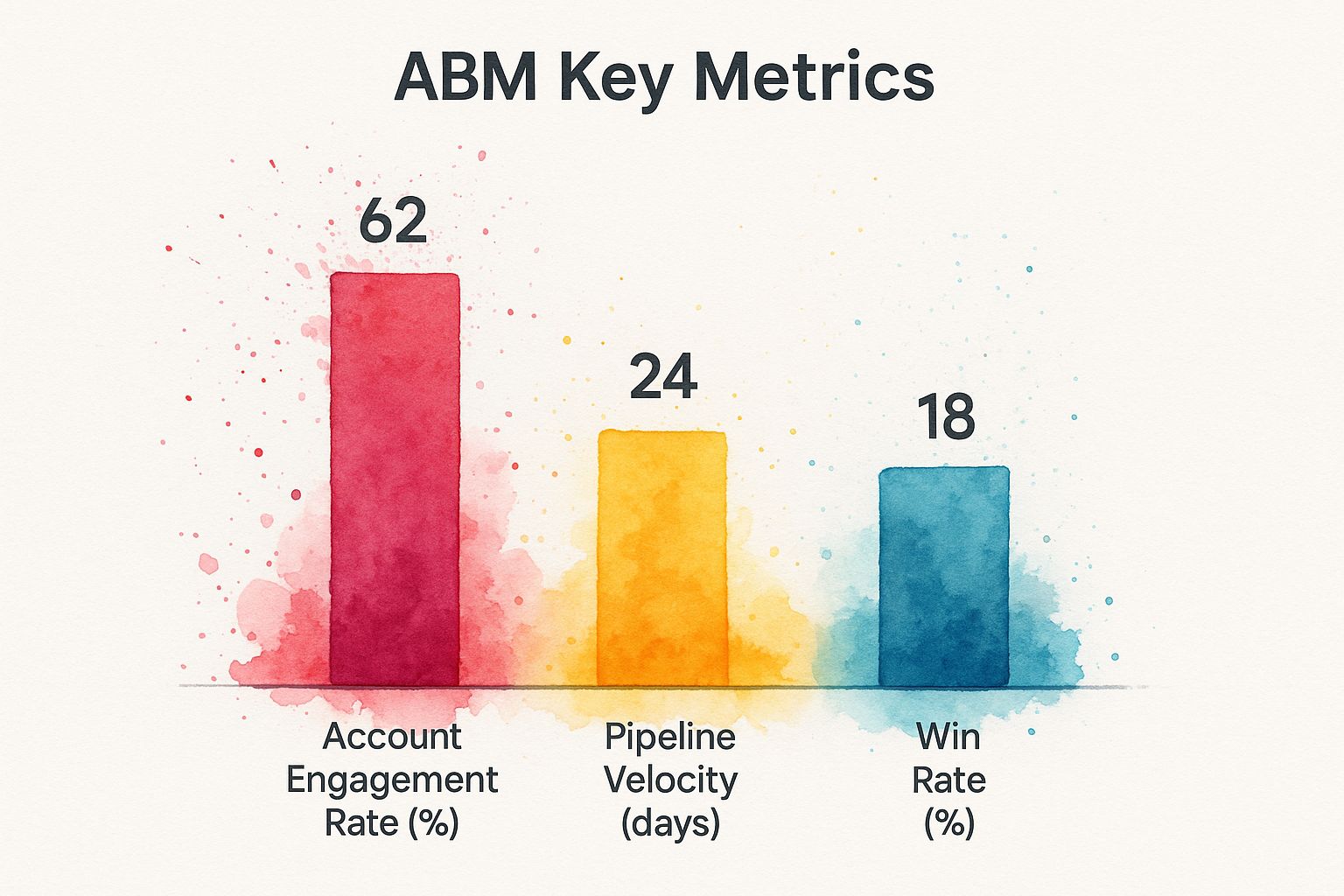Are you tired of marketing efforts that pull in low-quality leads and go nowhere? With Account Based Marketing (ABM), you can flip the script by focusing your resources on a hand-picked group of high-value accounts.
Think of it less like fishing with a net and more like spear fishing. It’s precision targeting for bigger wins.
What Is Account Based Marketing?
ABM is a growth strategy that treats your best-fit accounts as markets of one. It reverses the old-school marketing funnel.
You stop wasting budget on broad campaigns that attract unqualified prospects. Instead, your sales and marketing teams join forces to identify, engage, and win over your dream clients. This unified approach gets everyone rowing in the same direction.
The Core Philosophy Of ABM
At its heart, ABM is about quality over quantity. The process starts by identifying companies that gain the most from what you offer. These aren’t just leads; they’re future partners.
Once you have your target list, you craft hyper-personalized campaigns. Every piece of content, every ad, and every email is built for them. This level of personalization makes your brand impossible to ignore. For a deeper dive, this guide on what is account based marketing is a great resource.
The table below breaks down the shift in thinking.
| Aspect | Traditional Marketing (The Net) | Account Based Marketing (The Spear) |
|---|---|---|
| Primary Goal | Generate a high volume of individual leads. | Land and expand specific, high-value company accounts. |
| Targeting | Broad, based on general personas and demographics. | Narrow and deep, focused on a pre-defined list of target accounts. |
| Marketing & Sales | Operate in separate silos; marketing hands off leads to sales. | Fully aligned and collaborate from start to finish. |
| Communication | One-to-many. Generic messaging for a wide audience. | One-to-one or one-to-few. Hyper-personalized for each account. |
| Key Metrics | Cost per lead, lead volume, website traffic. | Account engagement, pipeline velocity, deal size, lifetime value. |
| Process Flow | Attract leads, nurture them, qualify them, then hand off to sales. | Identify accounts, research them, engage contacts, then land deals. |
As you can see, ABM is a go-to-market philosophy. It prioritizes depth and relationships over sheer volume.
Why It Delivers Better Results
This strategic focus yields impressive results. Up to 76% of marketers report higher ROI with ABM compared to other strategies.
But it doesn’t stop there. Companies using ABM have seen a 38% higher sales win rate and 91% larger deal sizes. By concentrating on high-value accounts, you build deeper relationships that lead to more substantial deals.
Account based marketing doesn’t just generate leads; it builds relationships. By treating your best prospects like VIPs, you transform from another vendor into an indispensable partner.
This shift in mindset separates successful B2B companies from the rest.
Adopting ABM lets you align your team around a single, powerful goal: winning the accounts that can transform your business.
Building Your Foundation by Identifying High-Value Accounts
Ready to focus your B2B marketing where it will move the needle? The success of your account-based marketing program hinges on one choice – which companies you target.
This isn’t about guesswork. It’s a deliberate process of figuring out your best customers and finding more like them. Let’s get this right.
Start with Your Ideal Customer Profile
Before finding your dream clients, you need a blueprint. In ABM, that blueprint is your Ideal Customer Profile (ICP). It’s a clear description of the company that gets the most value from your solution.
Think of your ICP as the ultimate filter. It helps you separate high-potential accounts from time-wasters. A solid ICP ensures your sales and marketing teams are aligned from day one.
To build it, you need to dig into your data. Look for common threads among your happiest, most profitable clients.
- Firmographics: What industries are they in? How big are they in employee count or revenue? Where are they located?
- Technographics: What’s in their tech stack? Are they using complementary software?
- Behavioral Data: How did they find you? What did their buying journey look like? High engagement is a huge clue.
When you analyze these traits, a picture of your perfect-fit customer emerges.
From Profile to Target Account List
Once your ICP is locked in, you build your Target Account List (TAL). This is your hand-picked roster of companies that match your ICP and represent the biggest revenue potential. It’s your strategic hit list.
While ABM flips the traditional funnel, understanding broader B2B lead generation strategies provides great context. Your TAL is where you apply that knowledge with surgical precision.
Look for companies already showing signs of life. Are they visiting your pricing page? Are executives liking your posts on LinkedIn? These buying intent signals are strong indicators.
Your Target Account List isn’t just a sales tool; it’s a company-wide commitment. Every name on that list should be a company that both marketing and sales agree is worth the combined effort to win over.
That shared ownership is the secret sauce.
Tiering Your Accounts for Maximum Efficiency
Let’s be real: not all target accounts are equal. Some are “whale” opportunities, while others are simply solid fits. To spend your time and money wisely, you need to segment your TAL into tiers.
- Tier 1 (One-to-One): These are your top 5–10 dream accounts. They get “white glove” treatment with the most personalized marketing and sales efforts.
- Tier 2 (One-to-Few): This group is a bit larger, maybe 10–50 accounts that share similar traits. They receive campaigns personalized for their industry, but with a more scalable approach.
- Tier 3 (One-to-Many): This is your broadest list of good-fit accounts. Here, you use technology to deliver lightly personalized messages at scale, keeping your brand top-of-mind.
Tiering lets you invest your most intensive resources where they’ll generate the highest return. Get this right, and you’ll focus all your energy on the opportunities most likely to become your next great customers.
Crafting Personalized Campaigns That Connect

You’ve identified your dream clients. Now you need to craft a message they actually care about. In ABM, generic content is your worst enemy. It’s time to stop sounding like another vendor and start acting like a partner.
Real personalization is more than a {first_name} tag. It’s about diving deep into each account’s world – understanding their frustrations, goals, and key decision-makers.
Uncovering the Insights That Matter
Before you write a headline, become an expert on your target accounts. Put on your detective hat. You’re digging for intelligence that makes your outreach feel like a helpful conversation.
This research is non-negotiable. It separates a generic email blast from a message that screams, “We get you.”
- Annual Reports & Earnings Calls: These are gold mines for public companies. You’ll find strategic priorities and challenges, often in the C-suite’s own words.
- LinkedIn Sleuthing: Go beyond the company page. Follow key decision-makers. Their activity is a roadmap to what’s on their mind.
- Job Postings: A company’s hiring needs are a massive tell. Are they building a new cybersecurity team? For a security vendor, that’s a flashing green light.
These insights are the raw materials for campaigns that hit home.
Mapping Your Content to Their Journey
Armed with insights, you can serve up the right content at the right time. The goal is to guide them from “we have a problem” to “you are the solution.” You can learn more in our guide on how to create a B2B content strategy.
This isn’t about carpet-bombing them with whitepapers. It’s a strategic, sequenced delivery.
- Awareness Stage: The account knows they have a problem. Share high-level thought leadership, like industry reports that help them frame their problem.
- Consideration Stage: They’re actively looking for solutions. It’s the perfect time for personalized webinars, detailed case studies, and ROI calculators.
- Decision Stage: They’re comparing you against competitors. Offer a custom demo that focuses only on features that solve their pain points.
A journey-based strategy makes every touchpoint feel valuable. This is how you build trust.
Bringing Your Campaign to Life
Okay, time to execute. Your channels need to create a seamless experience for the buying committee.
The B2B world is more digital than ever. Mobile channels make up nearly 50% of B2B ad spending, so multi-channel strategies are essential. ABM excels here, with 64% of client-centric firms reporting higher ROI from personalized, multi-touch experiences.
Here are a few ways to make every touchpoint count:
- Hyper-Personalized Emails: Go beyond the name. Reference a recent company announcement or a post they shared on LinkedIn.
- Custom Landing Pages: Imagine a landing page built for them, with their logo and content that speaks to their industry’s headaches.
- Surgical Ad Targeting: Use platforms like LinkedIn to run ads shown only to employees with specific job titles at your target companies.
- High-Value Direct Mail: In a digital world, something physical cuts through the noise. Send a thoughtful package to a key executive.
The ultimate goal of a personalized campaign isn’t just to get noticed – it’s to be remembered. When your message makes a decision-maker feel truly understood, you’re no longer selling to them; you’re starting a collaboration.
This lets you create campaigns that don’t just generate leads. They build relationships that your competition can’t match.
Uniting Sales and Marketing for Flawless Execution

To nail account based marketing, sales and marketing must work so closely that your targets can’t see the seam. An ABM strategy with disjointed teams is like an orchestra with two conductors – you get noise, not music.
This partnership is the linchpin of execution. When sales and marketing share the same playbook, goals, and numbers, they become an unstoppable force. This synergy creates a compelling experience and dramatically improves your odds of closing the deal.
Building a Single, Unified Team
First, the wall between sales and marketing must come down. In ABM, there’s no “handoff.” Instead, you have a collaborative loop where both teams work in lockstep.
Think of it as a doubles team in tennis, not a relay race. Marketing doesn’t just lob the ball and walk off. They arm sales with deep insights, personalized content, and targeted ads.
At the same time, sales feeds marketing a constant stream of on-the-ground intelligence. This real-time feedback loop is gold. It lets marketing tweak messaging and double down on what’s working.
When sales and marketing operate as one revenue team, they stop arguing over who gets credit. Instead, they focus on what really matters: engaging the right accounts and closing business.
This unity changes everything. Companies with tight sales and marketing alignment see 28% faster revenue growth and 33% higher profitability.
The Collaborative ABM Playbook
A shared mission needs a formal ABM Playbook. This acts as your single source of truth, co-created by leaders from both teams.
Your playbook must clearly define roles, responsibilities, and rules of engagement. This is a huge part of achieving better marketing and sales alignment.
Here’s what your playbook must nail down:
- Shared Goals and Metrics: Ditch separate KPIs. Rally around unified metrics like account pipeline generated, pipeline velocity, and win rate.
- Ideal Customer Profile (ICP) and Target Account List (TAL): Both teams must agree on what a high-value account looks like and sign off on the final list.
- Roles and Responsibilities: Get granular. Define specific tasks for marketing and sales for each campaign tier.
- Communication Cadence: Set a rhythm. This should include weekly sync-ups, joint quarterly planning sessions, and a shared Slack channel.
This playbook isn’t meant to collect dust. It’s a living document for daily use.
Arming Sales with Actionable Intelligence
In ABM, marketing’s most important job is to empower sales with the intelligence for smart, timely conversations.
Think of marketing as an intelligence agency. They feed sales a steady diet of actionable insights.
- Intent Data: Who from the target account is researching your competitors? This tells a sales rep exactly when to reach out and what to talk about.
- Engagement Signals: Did the CFO download your whitepaper? Did the VP of Engineering attend your webinar? These are green lights for sales to follow up.
- Personalization Hooks: Marketing can provide reps with golden nuggets about individual contacts. These details turn a cold call into a warm conversation.
This unified front is what wins their confidence – and their business.
Measuring the ABM Metrics That Actually Matter
How do you know if your account based marketing is working? Stop chasing vanity metrics like clicks and impressions. Start focusing on the numbers that move the needle on revenue.
Traditional dashboards are often a firehose of data. ABM requires a different way of looking at things. You’re measuring the quality of engagement, not the volume of leads.
The infographic below zeroes in on the core metrics that shift the conversation from activity to impact.

ABM success is all about deeper engagement, faster deal cycles, and higher win rates.
Core Metrics for Your ABM Dashboard
To get a clear picture, your dashboard needs to tell a story about account penetration and revenue influence. Zoom in on the metrics that draw a straight line from your team’s efforts to the bottom line.
These are the numbers that truly matter:
- Account Engagement: This is more than a click. It’s a heatmap showing how deeply your target accounts interact with your brand across every channel. Are the right people paying attention?
- Pipeline Velocity: How fast do target accounts move from first touch to closed deal? A well-oiled ABM program should shorten the sales cycle. Faster velocity means quicker revenue.
- Average Deal Size: Because ABM focuses on your best-fit prospects, your average deal size should climb. This is a powerful signal that your strategy is working.
- Win Rate within Target Accounts: What percentage of opportunities within your TAL are you closing? A high win rate proves your personalized approach is resonating.
To get a complete view, it’s essential to track the right KPIs from the very beginning.
Essential ABM Metrics and Their Meaning
| Metric | What It Measures | Why It Matters for B2B |
|---|---|---|
| Account Engagement Score | A composite score of all interactions (site visits, email opens, content downloads) from individuals within a target account. | Identifies which accounts are “warming up” and showing genuine interest, signaling the best time for sales to engage. |
| Pipeline Velocity | The average time it takes for a deal to move from the first touchpoint to close-won within your target account list. | A decreasing timeframe shows your ABM efforts are effectively accelerating the buying journey and improving efficiency. |
| Coverage | The percentage of key contacts (e.g., decision-makers, influencers) within a target account that you have successfully engaged. | High coverage indicates you’re building consensus across the buying committee, not just talking to a single person. |
| Win Rate | The percentage of deals closed-won from the total number of opportunities created within your target account list. | This is the ultimate proof of ABM’s effectiveness. A rising win rate shows your messaging and targeting are spot-on. |
| Average Deal Size | The average revenue value of closed-won deals from your target accounts. | An increasing average deal size confirms that your focus on high-value accounts is leading to more substantial business. |
Keeping an eye on these numbers ensures you’re not just busy, but productive.
Tracking Influence and Reach
You also need to understand your influence within each account. Are you talking to one person, or are you building consensus across the buying committee?
A critical part of ABM is mapping out all key players – the champion, the decision-maker, the influencer. The goal is to watch your coverage grow, meaning you’re successfully engaging more essential contacts.
Effective ABM isn’t just about getting a foot in the door; it’s about earning a seat at the table with every key stakeholder. When multiple decision-makers see your value, your deal is far more likely to close.
This detailed tracking helps you spot gaps instantly.
Proving ROI and Optimizing for the Future
Ultimately, measurement is about proving the return on your ABM investment. Research shows ABM can boost pipeline conversion by 14% and increase marketing-to-sales lead conversion by 25%. Other studies found 75% of businesses see better buyer engagement, which lifts overall account engagement by 28%.
These are significant business outcomes. Tracking the right metrics lets you report confidently on the revenue your ABM program generates. You’ll also gather intel for smart decisions. For a deeper look, check out these tips on how to measure and improve sales performance.
This data-driven approach allows you to shift from guessing what works to knowing what works. This lets you double down on your most effective tactics for even bigger wins next quarter.
Scaling Your ABM Program with the Right Technology

You’ve had early wins with ABM. But how do you grow from a handful of accounts to dozens, or even hundreds, without losing that personal touch?
The short answer is: you can’t do it manually. To scale a B2B program effectively, you need the right tech stack. But technology doesn’t replace the human element; it supercharges it. The right tools handle repetitive tasks, freeing up your team to build relationships.
The Core Components of an ABM Tech Stack
Think of your tech stack as a three-legged stool. Each leg supports a critical function. You need tools to find accounts, engage them, and prove it worked.
Your toolkit will fall into these three buckets:
- Identification and Data Platforms: These tools are your eyes and ears. They help you find your Ideal Customer Profile (ICP), discover new accounts, and add crucial data like intent signals.
- Engagement and Orchestration Platforms: This is your command center. These platforms let you run coordinated, multi-channel campaigns with personalized ads, emails, and website experiences.
- Measurement and Analytics Platforms: These tools give you the real story on campaign performance. They track key metrics like account engagement and pipeline velocity to prove your ROI.
Choosing the Right Tools for the Job
With so many software options, it’s easy to get overwhelmed. Avoid shiny object syndrome. Buy a tool because it solves a problem you have right now.
A common mistake is thinking technology is the strategy. It’s not. Technology is the engine that powers your strategy. Always start with your goals, then find the tools that help you get there.
If your sales team doesn’t know which accounts show buying signals, an intent data provider should be your first stop. If marketing is drowning in manual campaign setup, an orchestration platform is a game-changer.
Your tech stack is the backbone of a scalable account based marketing for B2B program. Selecting platforms that help you identify, engage, and measure equips your team to win bigger deals, faster.
Common Questions About Account Based Marketing
We’ve covered a lot of ground, but a few questions always come up. Let’s tackle the most common ones.
How Is ABM Different From Traditional Lead Generation?
Think of traditional lead generation as fishing with a giant net. You cast it wide, pull in a huge volume of leads, and then sift through them. It’s a numbers game focused on quantity.
Account based marketing is like spear fishing. You identify your perfect, high-value target accounts first. Then, you focus all your energy on landing those specific accounts. The mindset shifts from lead volume to account quality.
What Is a Common Mistake to Avoid When Starting ABM?
The single biggest pitfall is poor alignment between sales and marketing. If your teams don’t share the same playbook and goals, the strategy will crumble. Misalignment creates inconsistent messaging and wasted effort.
Before any campaign goes live, get both teams in a room. They need to build the Ideal Customer Profile (ICP) and Target Account List (TAL) together. They also must agree on success metrics. Communication isn’t just helpful; it’s critical.
Your ABM program is only as strong as the partnership between your sales and marketing departments. When they operate as a single, unified revenue team, you create a seamless experience that wins deals.
This unified front is non-negotiable. It ensures everyone is pulling in the same direction.
Can Small Businesses Use Account Based Marketing?
Absolutely. It’s a misconception that ABM is only for massive enterprises. The principles are effective for small businesses, and you don’t need a huge budget.
A smaller company can start with a “one-to-few” or “one-to-one” approach. The key to successful account based marketing for B2B isn’t budget size; it’s strategic focus.
Frankly, ABM is often more efficient for a small business. It stops you from spreading your budget too thin and delivers a much higher ROI. It’s how you punch well above your weight.
Ready to stop wasting resources on unqualified leads and start winning your dream clients? At The Digital Bloom, we build and execute data-driven account based marketing programs that deliver predictable B2B growth. Let’s create a strategy that turns your highest-value accounts into your best customers. Learn more about our approach at https://thedigitalbloom.com.

